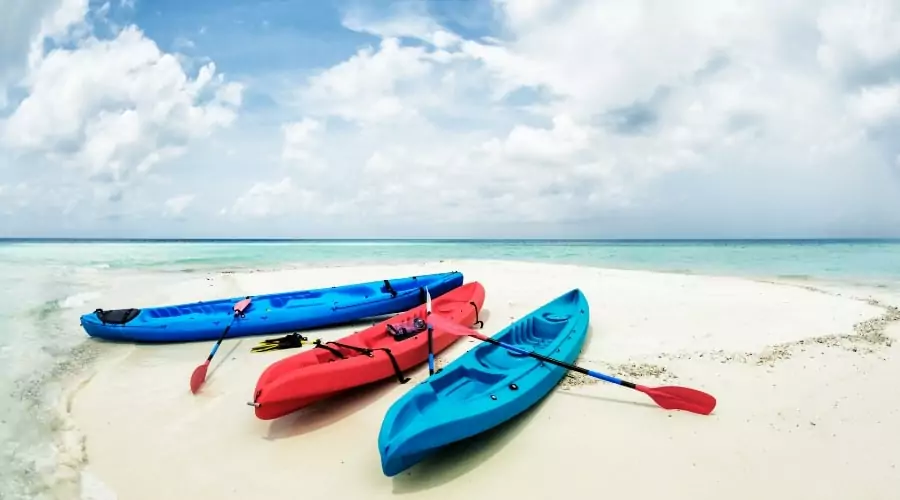Kayaking down a river can be an exhilarating adventure, but it can also be a daunting prospect for those who are new to the sport. While kayaking with a group can be a fun experience, paddling down a river by yourself can be a unique and rewarding experience.
However, before you set out on your solo kayaking trip, it’s important to understand the basics of how to kayak a river by yourself safely.
In this guide, we’ll cover some essential tips and techniques that will help you navigate a river on your own, so you can have a safe and enjoyable journey.
Choosing the Right Kayak
Types of Kayaks
There are various types of kayaks designed for different environments and activities. For river kayaking, you should look for a kayak specifically designed for river use. Whitewater kayaks and recreational kayaks are popular choices for river kayaking. Whitewater kayaks are shorter and more maneuverable, while recreational kayaks are longer and more stable.

Size and Weight Considerations
When choosing a kayak, consider your body size, weight, and personal preferences. A properly sized kayak will provide comfort, stability, and ease of handling. As a rule of thumb, taller and heavier paddlers should opt for larger kayaks, while smaller and lighter paddlers should go for smaller ones.
Essential Kayaking Gear
Personal Flotation Device (PFD)
Safety should be your top priority while kayaking. A good-quality PFD is essential for keeping you afloat in the water. Choose one that fits snugly, is comfortable, and allows for full arm movement.
Paddle
Select a paddle that’s the right length and weight for you. A lightweight paddle with a comfortable grip will help reduce fatigue and make paddling more enjoyable.
Helmet
A helmet is crucial for protecting your head from injury, especially in rough or rocky rivers. Choose a helmet designed for kayaking with proper ventilation and a secure fit.
Dry Bags and Storage
Keep your belongings safe and dry by using waterproof dry bags. Secure them to your kayak using straps or bungee cords, ensuring they won’t impede your movement.
Do you know: How to Kayak a River with One Car
Planning Your Kayaking Trip
Picking a Suitable River
Choose a river with a difficulty level that matches your skills and experience. Rivers are rated on a scale from Class I (easy) to Class VI (extremely difficult). As a beginner, stick to Class I or II rivers until you gain more experience.
Assessing River Conditions
Before embarking on your kayaking adventure, research the river’s conditions, including water levels, flow rate, and any known hazards. Consult local kayaking communities and online resources for up-to-date information.
Weather Considerations
Check the weather forecast for the day of your trip. Avoid kayaking in extreme weather conditions, such as heavy rain, strong winds, or thunderstorms.
Safety and Emergency Preparedness**
Prepare for potential emergencies by carrying a first aid kit, whistle, and a throw rope. Additionally, inform someone of your planned route and expected return time. Familiarize yourself with basic rescue techniques and emergency signals.
Kayaking Techniques
Launching Your Kayak
Find a suitable location to launch your kayak. This could be a boat ramp, a gentle slope, or a calm section of the river. Position your kayak parallel to the water’s edge, with the bow facing the river. Secure your paddle within reach, then step into the cockpit, keeping your weight centered. Once seated, adjust your footrests and fasten your spray skirt if applicable.
Paddling Strokes
Proper paddling technique is crucial for efficient and comfortable kayaking. The two fundamental strokes are the forward stroke and the sweep stroke. The forward stroke propels your kayak straight ahead, while the sweep stroke is used for turning. Practice these strokes on flat water before attempting river kayaking.

River Navigation
Navigating a river requires skill and knowledge of river features, such as eddies, waves, and currents. Learn to read the river by identifying these features and planning your route accordingly. Always scout rapids and obstacles from the shore before attempting to navigate them.
Dealing with Obstacles
Rivers can present various obstacles, such as rocks, fallen trees, or low-head dams. Learn to identify and avoid these hazards. If you encounter a challenging obstacle, it’s always safer to portage (carry your kayak) around it than to risk injury or damage to your kayak.
Related: Kayaking in Chicago River
Frequently Asked Questions (FAQs):
1. Is it safe to kayak a river alone?
Yes, it can be safe to kayak a river alone if you have the necessary skills, experience, and equipment. However, always inform someone of your plans and carry emergency gear.
2. What is the best type of kayak for river kayaking?
Whitewater kayaks and recreational kayaks are popular choices for river kayaking. Choose a kayak that suits your size, weight, and skill level.
3. How do I choose the right paddle for kayaking?
Select a paddle that is the right length and weight for your body size and kayak type. A lightweight paddle with a comfortable grip will make paddling more enjoyable.
5. How can I improve my kayaking skills?
Take lessons from a certified instructor, join a local kayaking club, or practice on flat water before attempting river kayaking. Learn to read river features and practice essential paddling strokes.
Kayaking on Rivers
Conclusion
Kayaking a river by yourself can be a rewarding and thrilling experience. By choosing the right kayak, equipping yourself with essential gear, planning your trip carefully, and practicing proper techniques, you’ll be well-prepared for a solo river kayaking adventure. Always prioritize safety and enjoy the beauty and excitement of the river.
